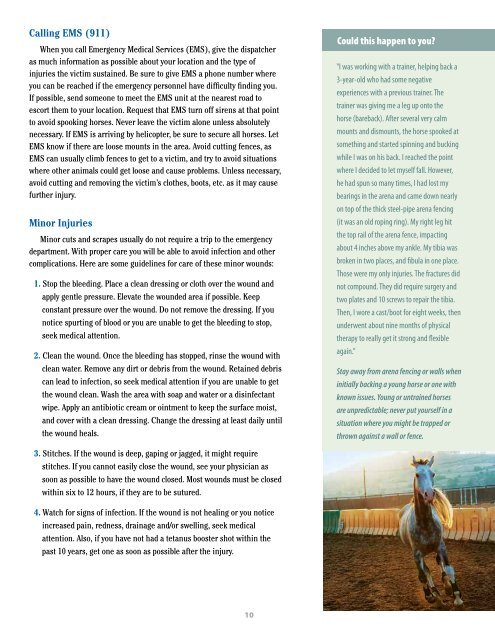Horse Related Injury Brochure - Alberta Equestrian Federation
Horse Related Injury Brochure - Alberta Equestrian Federation
Horse Related Injury Brochure - Alberta Equestrian Federation
Create successful ePaper yourself
Turn your PDF publications into a flip-book with our unique Google optimized e-Paper software.
Calling EMS (911)<br />
When you call Emergency Medical Services (EMS), give the dispatcher<br />
as much information as possible about your location and the type of<br />
injuries the victim sustained. Be sure to give EMS a phone number where<br />
you can be reached if the emergency personnel have difficulty finding you.<br />
If possible, send someone to meet the EMS unit at the nearest road to<br />
escort them to your location. Request that EMS turn off sirens at that point<br />
to avoid spooking horses. Never leave the victim alone unless absolutely<br />
necessary. If EMS is arriving by helicopter, be sure to secure all horses. Let<br />
EMS know if there are loose mounts in the area. Avoid cutting fences, as<br />
EMS can usually climb fences to get to a victim, and try to avoid situations<br />
where other animals could get loose and cause problems. Unless necessary,<br />
avoid cutting and removing the victim’s clothes, boots, etc. as it may cause<br />
further injury.<br />
Minor Injuries<br />
Minor cuts and scrapes usually do not require a trip to the emergency<br />
department. With proper care you will be able to avoid infection and other<br />
complications. Here are some guidelines for care of these minor wounds:<br />
1. Stop the bleeding. Place a clean dressing or cloth over the wound and<br />
apply gentle pressure. Elevate the wounded area if possible. Keep<br />
constant pressure over the wound. Do not remove the dressing. If you<br />
notice spurting of blood or you are unable to get the bleeding to stop,<br />
seek medical attention.<br />
2. Clean the wound. Once the bleeding has stopped, rinse the wound with<br />
clean water. Remove any dirt or debris from the wound. Retained debris<br />
can lead to infection, so seek medical attention if you are unable to get<br />
the wound clean. Wash the area with soap and water or a disinfectant<br />
wipe. Apply an antibiotic cream or ointment to keep the surface moist,<br />
and cover with a clean dressing. Change the dressing at least daily until<br />
the wound heals.<br />
Could this happen to you<br />
I was working with a trainer, helping back a<br />
3-year-old who had some negative<br />
experiences with a previous trainer. The<br />
trainer was giving me a leg up onto the<br />
horse (bareback). After several very calm<br />
mounts and dismounts, the horse spooked at<br />
something and started spinning and bucking<br />
while I was on his back. I reached the point<br />
where I decided to let myself fall. However,<br />
he had spun so many times, I had lost my<br />
bearings in the arena and came down nearly<br />
on top of the thick steel-pipe arena fencing<br />
(it was an old roping ring). My right leg hit<br />
the top rail of the arena fence, impacting<br />
about 4 inches above my ankle. My tibia was<br />
broken in two places, and fibula in one place.<br />
Those were my only injuries. The fractures did<br />
not compound. They did require surgery and<br />
two plates and 10 screws to repair the tibia.<br />
Then, I wore a cast/boot for eight weeks, then<br />
underwent about nine months of physical<br />
therapy to really get it strong and flexible<br />
again.”<br />
Stay away from arena fencing or walls when<br />
initially backing a young horse or one with<br />
known issues. Young or untrained horses<br />
are unpredictable; never put yourself in a<br />
situation where you might be trapped or<br />
thrown against a wall or fence.<br />
3. Stitches. If the wound is deep, gaping or jagged, it might require<br />
stitches. If you cannot easily close the wound, see your physician as<br />
soon as possible to have the wound closed. Most wounds must be closed<br />
within six to 12 hours, if they are to be sutured.<br />
4. Watch for signs of infection. If the wound is not healing or you notice<br />
increased pain, redness, drainage and/or swelling, seek medical<br />
attention. Also, if you have not had a tetanus booster shot within the<br />
past 10 years, get one as soon as possible after the injury.<br />
10


